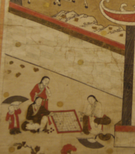Áo giao lĩnh


The áo giao lĩnh (襖交領), also known as the giao lãnh y (交領衣). Folk often call it áo tràng vạt (襖長拔) or áo tràng xiên, referred to as áo tràng, was a traditional cross-collared robe worn by Vietnamese before the 19th century. During the Nguyễn dynasty, it was replaced by the áo ngũ thân and became obsolete.[1][2] The áo giao lĩnh was also identical to the cross-collar robe worn by the Han Chinese.[3]
History[]
Prior to 18th Century[]
Prior to the 18th century, nobles wore the áo giao lĩnh which were Han Chinese clothing.[4] During the Lê dynasty (1428 – 1789 AD), aristocrats wore the áo giao lĩnh.[5]
18th Century[]
In the 18th century, the Áo Ngũ Thân (the precursor of the ao dai) replaced the áo giao lĩnh in order to meet the clothing requirement decreed by the Nguyen dynasty court during the rule of Lord Nguyễn Phúc Khoát in 1744 in order to distinguish the clothing worn between the people under his rule from the people ruled by the Trinh Lords.[4][5][3] The precursor of the ao dai then became the official clothing for both men and women in the South of Vietnam.[6]
19th Century[]
In the 19th century, under the rule of Emperor Minh Mang (r. 1820-1841), the clothing in Vietnam was finally standardized throughout the entire country when Emperor Minh Mang decreed that the ao dai had to become the national dress for all the regions under his rule.[7][8] The ao dai thus became the daily clothing of the Vietnamese.[8]
21st Century[]
In the 21st century, áo giao lĩnh worn in the 15th century was depicted in a book titled Weaving a Realm published by the Vietnam Centre (a non-profit organization which aims to promote the culture and image of Vietnam[9]).[10][11] The authors of the book mostly consisted of dress makers, artists, stylists, photographers, proof readers and editors (but lacked the presence of historians and archeologists) attempted to reconstruct the ancient clothing worn by Vietnamese through extensive historical research.[12] However, due to the lack of funds, the reconstructed clothing were not made with original materials or techniques.[12]
Gallery[]
- Áo giao lĩnh as depicted in various paintings and photos:

Portrait of Prince from the 17th century. He wears a cross-collared robe (áo giao lĩnh) which was commonly worn by Vietnamese aristocrats before the 19th century

Giảng học đồ (Teaching), 18th century, Hanoi Museum of National History. Scholars and students wear cross-collared gowns (áo cổ chéo) – unlike the buttoned áo dài

Southern Vietnamese

The Vietnamese civilians in Lê dynasty

Two women and a child in Hanoi around the 1700s.
See also[]
References[]
- ^ Vu, Thuy (2014), "Đi tìm ngàn năm áo mũ", Tuoi Tre, retrieved June 16, 2015
- ^ Unknown, T.Van (2013), "Ancient costumes of Vietnamese people", Vietnamnet, retrieved June 16, 2015
- ^ a b Fiona. "A Brief History of Traditional Vietnamese Ao Dai". Travel information for Vietnam from local experts. Retrieved 2021-06-30.
- ^ a b "All about Vietnam Traditional Costumes". www.indochinatour.com. Retrieved 2021-06-30.
- ^ a b "Áo Dài: History | VSAcademy | UNAVSA". Retrieved 2021-06-30.
- ^ Times, Vietnam (2020-07-09). "Precious photos of Vietnam's iconic Ao Dai in the old time". Vietnam Times. Retrieved 2021-06-30.
- ^ "The Vietnamese "Áo dài" | Tập San Việt Học". Retrieved 2021-06-30.
- ^ a b "Vietnam's Ao Dai to be highlighted at Hue Festival 2020". en.nhandan.vn. Retrieved 2021-06-30.
- ^ "About Us | Vietnam Centre - Bring Vietnam To You". Vietnam Centre. Retrieved 2021-07-01.
- ^ Times, Vietnam (2020-06-14). "Weaving a Realm: Bilingual book introduces Vietnam's costumes from the 15th century". Vietnam Times. Retrieved 2021-07-01.
- ^ ""Weaving A Realm" Book Crowdfunding Project | Vietnam Centre - Bring Vietnam To You". Vietnam Centre. Retrieved 2021-07-01.
- ^ a b "Book Review: Weaving a Realm, Vietnamese clothing from around 1500 AD | EXARC". exarc.net. Retrieved 2021-07-01.
External links[]
- Vietnamese clothing
- Vietnamese words and phrases
- History of Asian clothing




